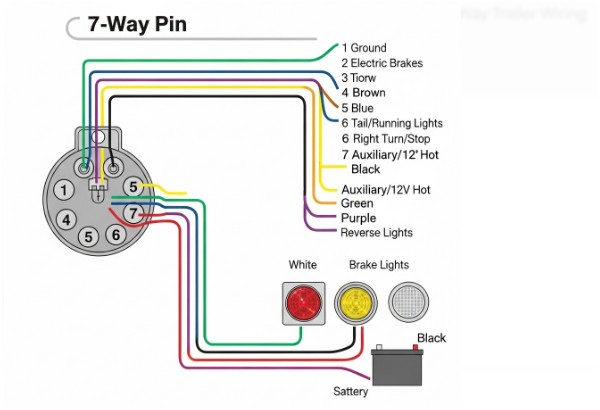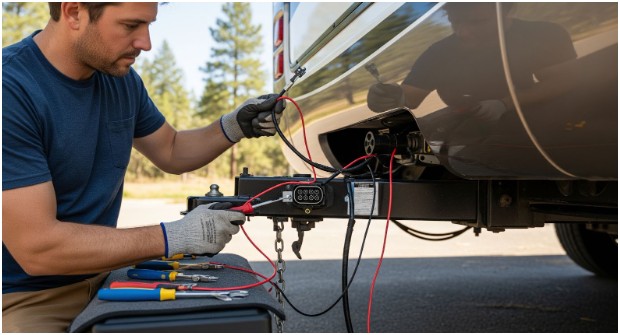When you’re towing a travel trailer, boat, or utility hauler across American highways, knowing how your trailer wiring works isn’t optional—it’s essential. One of the most common questions I hear from first-time (and even seasoned) RVers is: “How does the 7-way trailer plug work, especially with brakes involved?”
If that’s what brought you here, this is your complete guide to understanding a 7-way trailer wiring diagram with brakes—and why getting it right could be the difference between a smooth ride and a towing nightmare.
What Is a 7-Way Trailer Connector?

Image Source: Towlos Trailer Rentals
A 7-way trailer plug, often referred to as an RV-style blade connector, is the standard wiring configuration used in most trailers in the U.S. It allows your tow vehicle to send electrical signals to your trailer—controlling everything from turn signals and brake lights to electric brakes and auxiliary power.
Why does it matter? Because without proper wiring, your trailer lights may not work—or worse, your trailer brakes may fail entirely.
Standard 7-Way Trailer Wiring Diagram with Brakes

Let’s break down what each pin on the 7-way plug does and what color wire typically corresponds to each function. This is the standard setup used in most modern trailers:
Pin 1 – Ground Wire (White)
This pin connects the trailer’s electrical system to the tow vehicle’s chassis ground. Without this wire properly secured, nothing else will work consistently.
Pin 2 – Electric Brakes (Blue)
This wire carries power from your tow vehicle’s brake controller to the electric trailer brakes. It’s a critical safety feature when hauling heavy loads.
Pin 3 – Tail/Running Lights (Brown)
Your trailer’s running lights, including tail lights and marker lights, connect through this wire. It helps keep your trailer visible at night or in low-light conditions.
Pin 4 – Left Turn Signal and Brake Light (Yellow)
This wire activates the left turn signal and left brake light. It syncs with your vehicle’s left-side signals.
Pin 5 – Right Turn Signal and Brake Light (Green)
This wire mirrors the function of Pin 4 but on the right side of the trailer.
Pin 6 – Reverse Lights (Purple)
If your trailer has backup lights, this wire powers them. Not all trailers have this feature, but it’s becoming more common.
Pin 7 – 12V Auxiliary Power (Black)
This wire provides a constant 12-volt power supply. It can be used to charge the trailer’s battery, power interior lights, or keep a fridge running during travel.
Why Your Brakes Depend on Proper Wiring
If you’re asking about a 7-way trailer wiring diagram with brakes, chances are you’re towing something that needs those brakes to work. Here’s what’s crucial:
- Brake Controller Integration: Your tow vehicle needs a working brake controller. It sends variable current through the blue wire depending on how much braking power you need.
- Consistent Ground: Without a solid ground, the brake signal may fail, causing lag or total brake loss.
- Proper Gauge Wire: The blue brake wire should be a heavier gauge (usually 10- or 12-gauge) to handle the current load.
How to Wire a 7-Way Trailer Plug (Step-by-Step)
Here’s how I wire up a 7-way plug on my trailer—and what you can do too.
- Start by Disconnecting All Power
Always disconnect your trailer’s battery or any external power source before starting.
- Strip the Wires Back
Use a wire stripper to expose about ½ inch of clean copper on each wire.
- Match Each Wire to Its Correct Pin
Use the standard configuration above to connect each wire to the correct pin in the plug. You’ll often find a wiring diagram stamped inside the plug cover.
- Crimp or Solder Connections
For durability, crimp connectors are fine, but I prefer soldering for a more reliable, long-term bond—especially for the brake wire.
- Seal with Heat Shrink Tubing or Electrical Tape
Weatherproof every connection to avoid corrosion and failure, especially on the exposed underside of your trailer.
- Test Every Connection
Use a circuit tester or plug into your tow vehicle to verify that tail lights, blinkers, brakes, and auxiliary power all work properly.
What If Your Trailer Wiring Doesn’t Match?
Here’s where things get tricky. While the 7-way wiring color standard is widely followed in the U.S., it’s not a guarantee:
- Older Trailers: May use different color codes or combine lighting functions.
- Custom Builds: Might use non-standard pins for features like solar charging or electric jacks.
Always refer to your trailer’s manufacturer documentation or test each wire with a multimeter before splicing anything. Never assume color = function.
Common Wiring Mistakes to Avoid
Even pros can mess this up. Here are some of the most common issues I’ve seen (and made):
- Ground wire not properly attached to clean, bare metal
- Reverse light wire (purple) mistakenly connected to brakes
- 12V power connected directly to battery with no inline fuse
- Mixing up left and right signal wires
- Underrated wire gauge for trailer brakes
Trailer Brake Controller Tips
Getting your trailer’s brakes wired is only half the battle—you need a reliable brake controller in your vehicle too.
- Time-Delayed Controllers send braking power after a fixed delay. Easy to install but less smooth.
- Proportional Controllers apply braking force relative to your vehicle’s deceleration. They’re pricier but give you way better control.
Pro tip: Always calibrate your controller with your trailer loaded as you intend to tow.
Frequently Asked Questions (FAQs)
1. How do I know if my 7-way plug is wired correctly?
Use a circuit tester or plug it into your tow vehicle and check each function: tail lights, turn signals, brakes, and 12V power. Every pin should match its function per the standard wiring diagram.
2. Do I need a brake controller for my trailer?
If your trailer has electric brakes (and weighs over 3,000 lbs in most states), then yes—you’re legally and safely required to have a brake controller installed.
3. What gauge wire should I use for trailer brakes?
You should use at least 10- or 12-gauge wire for the electric brake circuit to ensure it handles the current without overheating or losing voltage.
4. Can I power trailer accessories from the 12V pin?
Yes! The black 12V power wire can charge your trailer’s battery, run lights, or power interior devices. Just make sure your tow vehicle can handle the load.
Wrapping Up the Wires: Stay Safe, Stay Connected
So, what does a 7-way trailer wiring diagram with brakes really give you? Peace of mind. When every wire is in place—grounded, tested, and connected—you’re not just towing a trailer; you’re hauling safely, confidently, and legally.
Whether you’re wiring from scratch or fixing a flaky connection, following the correct 7-way diagram is key to safe towing on American roads. Take the time to wire it right, and your future self (and brakes) will thank you.














